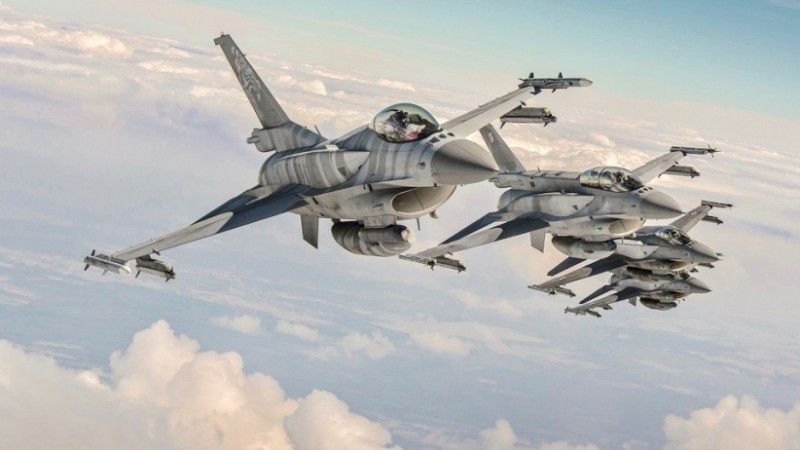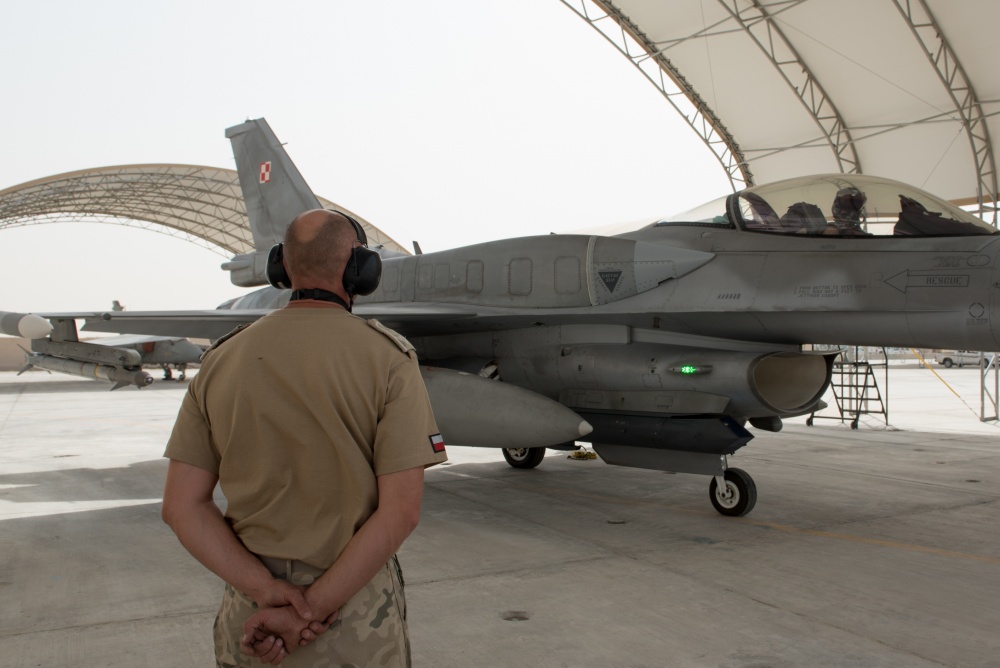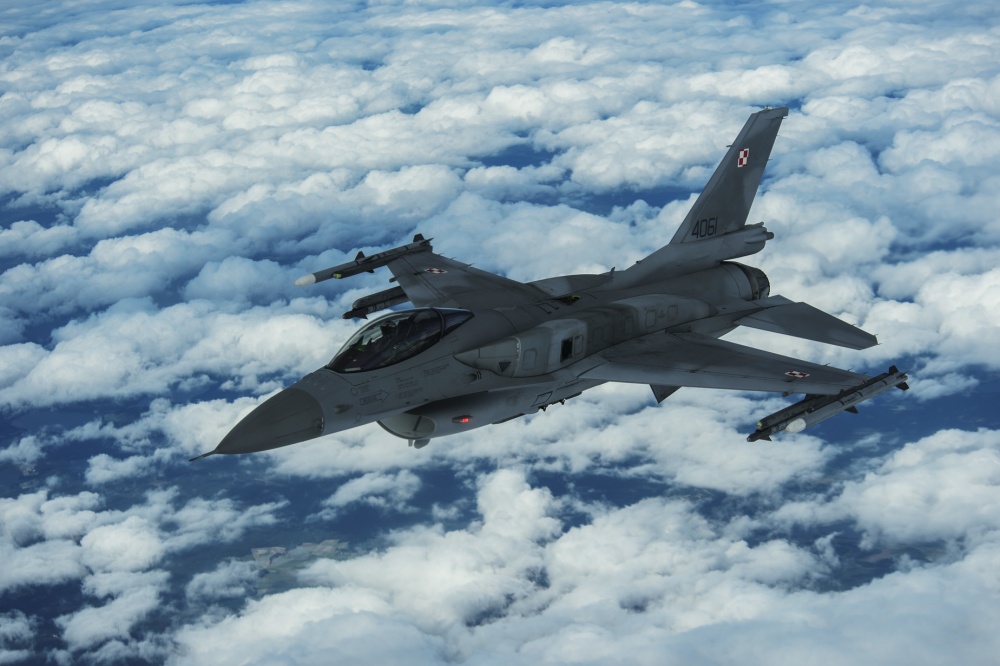Strona główna
Number of Flightworthy F-16 Jets in the Polish Air Force Unveiled

Since some time now, questions have been emerging with regards to the conditions of the Polish F-16C/D Jastrząb fleet. The worrying reports are somewhat well-grounded, considering the problems associated with another combat platform, the MiG-29. Is the percentage of combat-capable F-16 high enough to meet the standards in force, concerning these jets and implemented by the NATO nations? How many jets are we speaking about? Defence24 has obtained information on that matter.
A few days after Poland placed an order concerning two squadrons of F-35A 5th generation MRCA, another discussion began, with regards to other type of combat aircraft operated by the Polish military: F-16C/D Block 52+ Jastrząb. Some suggestions also emerged that the technical condition of the fleet has seriously deteriorated.
If that turned out to be true, this would be a sad symptom, both for the Polish national security, as well as for the Polish taxpayers. This would be even more pronounced as the Air Force is one of the most modern branches of the Polish military.
Conclusions regarding that matter are based on lack of availability of one piece of information. Here we are referring to lack of an answer provided to the question as follows: How many of the Polish F-16C/D aircraft remain ready, at the present time, to conduct “combat sorties”? Meanwhile, the number of aircraft that are capable to operate is a sensitive and confidential piece of data that has not been released by the Polish Ministry of Defence by custom. The situation is also similar in other states, including the NATO member states.
The Polish Ministry of Defence released a general statement claiming that “the number of the F-16 jets is sufficient to carry out tasks assigned to the air force units.” The MoD added that the jet managed to fly “98.59% of the flight hours planned”. This is a satisfying result. However, one may also wonder whether 100% of the flight hours would be enough, in circumstances in which two MiG-29 squadrons remained grounded.
The responses issued by the Ministry have been interpreted as a proof that very low percentage of the F-16s is ready for operations. It was even suggested that just a couple of those jets remained flyable.
Number of Available Aircraft
Defence24 sent its own questions regarding that matter and the obtained replies suggest just the opposite.
According to spokesman of the General Command of the Armed Forces (DGRSZ) Lt. Col. Marek Pawlak: “It is a standard for the Air Force to maintain as high availability of the aircraft in operation as possible. Mission capability and availability of the aircraft are both determined on the basis of the adopted maintenance systems that include obligatory inspections that last anywhere between a few days to several weeks in case of the F-16s, depending on the complexity of the inspection and of the problems detected. For that reason, maintaining 100% availability of combat aircraft per annum is impossible, even theoretically, for any NATO member state. The information we have obtained shows that the combat mission availability value for the NATO MRCA is somewhere around 40 - 70 %. Within that context the Polish F-16 enjoy high level of operational readiness, within the top section of the scope mentioned above.
“The top part of the range” between 40 and 70% is more than 55%. At least 26-27 jets are ready for operations then, the number may even be higher (70% availability would translate into 33-34 aircraft).

So, what about the remaining aircraft? Polish Ministry of Defence addressed this matter claiming that so called “technical cannibalism”, involving temporary parts transfer between the aircraft is “a phenomenon that is commonly seen practiced by air forces all around the world for the purpose of maintaining readiness of the jets awaiting delivery of spares at a cost of the ones that are subjected to long, extended maintenance procedures”. At the same time, the MoD announced that this phenomenon only applies to single examples, not the whole fleet.
Considering the above, the most important answer is the one associated with the question whether the operational readiness is satisfactory and whether a situation as such is in fact common in the western air forces. Here we can refer to USAF availability data for the year 2018. According to Air Force Times, F-16C availability in the USAF is shaped at the level of 70.03% while in case of the F-16D the corresponding number is 66.24%. 70% is the approximate level associated with F-15C, D, and E aircraft. The situation has been worse in case of the 5th generation airframes that had availability at the level of around 50%. This has been justified by the “F-35 infancy period” and general problems associated with the F-22 operations.

Availability of the Polish aircraft is a bit lower than in case of the USAF airframes of the same type. However, the US Fighting Falcon fleet is much older, on average, than the Polish Jastrząb jets. It could have been better, as the Americans are driven to reach readiness at the level of 80%. However, we are not dealing with a tragedy or negligence.
Spares supply is the element that, seemingly, needs to be made more efficient here. Lt. Col. Pawlak claims the following: “The supervision of the system used to supply technical materials for the Polish military, for the aircraft, and maintaining the stock, is placed within the sphere of expertise of the Central Logistics Organ. The Armed Forces’ Support Inspectorate is treating the task of securing the F-16 operations with utmost priority. The technical support system for the F-16s is based on intergovernmental agreements between the Polish and the US government and on domestic agreements as well.
The system allows for diversification of acquisition and repairs of the “technical material means”. The waiting time before the assets are acquired or repaired depends on numerous external and internal factors.”
Among the external factors, the following have been listed: “availability on the market, manufacturing time defined by the US government, Polish priority in completion of the deliveries/repairs, time that the US government needs to negotiate agreements with Contractors concerning repairs or deliveries of the technical material means”. Among the internal (domestic) factors, the list is as follows: “obtaining proper authorizations for importing/exporting those means by the businesses completing the delivery agreements”.
Lt. Colonel also announced that the F-16 aircraft procured by Poland “feature systems that are not used by USAF and thus the US government’s negotiation with the manufacturers of those systems are longer than in case of the systems used by the US Air Force”.
Two 'Decomissioned' F-16s
Information emerged that two F-16 jets reportedly have been withdrawn, being “crossed out from the inventory in 2019”. What’s interesting, reportedly, one of the aircraft “crossed out” was to be heavily damaged by an American pilot who performed a hard landing flying that jet.
The information on the Polish F-16s that have been damaged beyond repair is overtly denied by the military and by the MoD:
“Aviation events involving a hard landing of an aircraft or its <<overshooting>> the runway are not conclusive when it comes to withdrawal of such aircraft. The technical documentation of the F-16 envisages possibilities of such occurrences and it also contains a number of procedures and checks that need to be undertaken with regards to the aircraft to make it airworthy again”, Pawlak said. “Since the moment when the F-16C/D have been introduced into the inventory of the Polish Air Force until now, none of the jets have been withdrawn. The registry of the military aircraft maintained by the Central Logistics Organ contains entries concerning 48 examples of the F-16 C/D”, he added.
What would happen if, in fact, one of the Polish F-16s suffered from permanent damage? Would we, as the citizens, have a chance to find out? It turns out - yes.
“A routine procedure implemented when the given aircraft is withdrawn from operations as a result of event envisages crossing that aircraft out from the military aircraft registry listing the aircraft operated by the Armed Forces and managed by the Central Logistics Organ. One of the way in which the public could be informed is the notification of aircraft decommissioning issued within the framework of mutual relationship of the CFE Treaty parties, with the states-parties receiving that notification, in line with a relevant Protocol on Information Exchange.”
Two aircraft that have been withdrawn, reportedly, is a curious number. This is the number of the Polish F-16s that actually do not fly. They are not included in the pool of 48 examples that constituted the bulk of the 2003 contract. They were a part of the extra package acquired along with the main portion. This refers to the old F-16A aircraft, formerly stored at the Davis-Monthan AFB in Arizona, acquired to teach the Polish ground crews to learn how to maintain the onboard systems. WZL No. 2 facility has been using these jets to learn to put paint coatings on and remove them. They can be easily distinguished from the remaining aircraft (F-16C). They have three-digit reg numbers on their tails: 549 and 561. Meanwhile, the Air Force’s jets have 4-digit reg numbers, from 4040 to 4087.
“Poland owns two additional legacy F-16s that have been withdrawn from operations, additionally procured from the US as educational exhibits used for the purpose of training the ground crews”, the MoD had stated recently.
“Unworthy” of Harpia?
Should anybody think that 27 operationally capable jets is too little to protect airspace of a country of Poland’s size, then he or she is probably right to believe so. However, that low number does not really stem from the poor maintenance, but it rather shall be associated with a low number of western combat aircraft procured so far. The quantitative shape of the fleet was also dependent on the availability of the Soviet-made aircraft: Su-22 (two squadrons until 2014, one squadron at the moment) and MiG-29 (two squadrons). The fact that Fitter and Fulcrum fleet is in agony, begging for replacement, is the main factor that places the Polish Air Force in dire straits - this has nothing to do with the availability of the F-16.
This is especially pronounced as unofficially Poland needs 10 squadrons, not 6 or 7 - this would translate into quantity of 160 aircraft. At the moment, considering the current F-16 availability levels (55-70%) the above would mean that 88-112 aircraft would be ready for taking off immediately.
Within that context, acquisition of extra 32 F-35A jets within the framework of the Harpia program should be perceived as a beneficial step, especially in the light of the fact that support chain associated with the F-35 would translate into higher availability. The “support system for the F-35 is organized differently than in case of the currently operated aircraft, F-16 in particular. The system has been designed with all of the F-35 users in mind and it is based on the Autonomic Logistics Information System (ALIS) and Global Support Solution (GSS) assets. In simple terms it provides a forecast for regional spare warehouses, so called Base Spare Package (BSP). The flow of spares between BSP and the regional storage facilities is coordinated via GSS on the basis of information transferred within ALIS. Spares supply as such, for all of the users, was to diminish the cost of maintaining the expected aircraft availability that is directly influenced by the availability of spares and short period of time required to deliver those spares to the user. Summing it up, the F-35 spares supply system is a novelty in the contemporary military aviation thus entailing a number of challenges and areas where it could be optimized.” - General Command of the Polish Armed Forces stated.
Thus the F-35 shall not be perceived as a certain failure for the Polish military, it is rather just another challenge - another - the first one came in a form of introducing the F-16 as the first western combat aircraft. The F-35 is also an opportunity to rectify the situation through implementation of new, higher standards and increasing of the overall number of combat-worthy aircraft.
